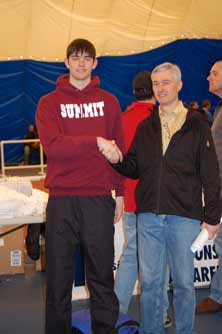Mark elected to take a shot at high jumping as a freshman, the first time it actually was offered. He explained, "I knew my dad was a high jumper and was really good at it, so I picked it up then. It kind of drove me in a sense – I've got to live up to my parents' legacy. He didn't show me a film (of him) until this year, but he had me studying video of Olympic high jumpers like Dwight Stones."
It wasn't that easy, however, to master the high jump.

Bob and Mark Jones.
Photo by Sue Jones
"It was pretty hard," Mark confessed. "I was still pretty uncoordinated. That's why I quit basketball. I had a lot to think about at once. I kind of got the hang of it as a sophomore."
Summit coach Adam Fern began working with Mark as a freshman. Fern recalled, "We saw that he was a better athlete than most of the kids out there. During the first drills we saw that he had a lot of potential in the high jump. He was all arms and legs – all over the place. We worked on slowing him down, working on drills and technique. He really became a technician. He went from 5-10 to 6-4 in six meets. I thought he definitely would get 7-0 before he graduated."
He really took off as a sophomore, clearing a best of 6-9 to win the Group II state title and long jumping 20 feet.
The summer before his junior year, Mark attended a track camp in Maine, directed by Dick Fosbury - who invented the revolutionary Fosbury Flop - and Bob learned something, too. Bob long had believed that "80 percent of high jumping happens while you're still on the ground. I adjusted that when he went to work with Dick Fosbury. He says 90 percent happens on the ground and the pit will take care of itself."
Mark's junior year was probably his most frustrating, because he only needed to add three more inches to his personal record to achieve his long-sought goal. He did come really close when he leaped 6-11 twice – once which earned him second place at the prestigious Penn Relays.
"With 50,000 people watching (at the Penn Relays), that was probably my most memorable meet," Mark said.
During the summer before his senior year, he cleared 6-10 3/4 to win his specialty at the New Balance Nationals in Greensboro, N.C. Coach Fern, noting that some jumps at lower heights are enormous, estimates that Mark was close to six inches over the bar when he cleared 6-10 3/4 at Greensboro.
His career bests in other events are: 22-9 in the long jump, 7.72 seconds in the indoor hurdles, 14.53 seconds in the 110 outdoor hurdles, 42-5 in the triple jump and 42-3 in the shot put. He actually won the Group II state triple jump last spring after just one practice.
"He's just one of those amazing athletes who can do anything," Fern said. "I think he can go 7-3 or 7-4 in the high jump right now. He's really strong. He's so athletic and big enough that he also can be a world-class decathlete."
Mark carries a solid 3.7 GPA and occasionally drops in on the Baking Club. Outside of school, he enjoys rock climbing and swimming. He chose the University of Colorado over Virginia and plans to major in geology.
"I like the outdoors and it's up against the Rockies," he said of his future college.
Asked about future goals, he replied, "Keep going up is all you can really do. I want to go as far as I can go, I guess. You never really know your limit. Maybe the Olympics – I'd love to do that."
Bob Jones lists two things that his son must improve to become a truly great high jumper. No. 1 is to develop a faster approach. No. 2 is to jump straight up instead of toward the bar.
He pointed out, "I don't think a high jumper reaches his prime until his late 20s. He has so much potential to improve. If you get everything right, jumping a foot over your head is a pretty good standard. That would be 7-7 (for Mark) and that's world class."
